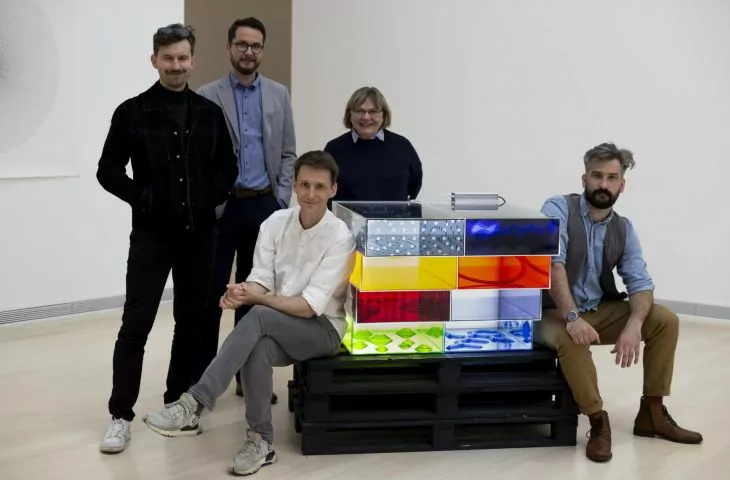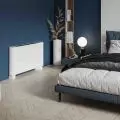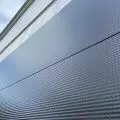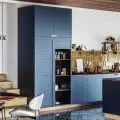The exhibition at the Hungarian Pavilion at the 17th Venice Architecture Biennale, according to its organizers, will be dedicated to exploring the possibilities inherent in the often contested and in many ways outdated heritage of contemporary architecture.
Dániel Kovács, curator of the Hungarian Pavilion, has invited collaboration on the exhibition, titled "Othernity. Reconditioning Our Modernist Heritage," twelve architectural studios from Central and Eastern Europe putting as many iconic buildings located in Budapest in their hands to try to reconcile the past with the future of architecture. Among the selected studios were two teams that included Polish architects - A-A Collective, which includes Zygmunt Borawski, and the Krakow office BudCud, which includes Agata Wozniczka and Mateusz Adamczyk.


 .
.
Domus Furniture Store building in Budapest, designed by Antal Lázár, Péter Reimholz (IPARTERV).
photo: Dániel Dömölky
Mateusz Adamczyk and Agata Wozniczka were assigned the now-empty, multi-story 1970s building formerly owned by the Domus Furniture Store chain (design: Antal Lázár, Péter Reimholz). The architect duo proposed transforming the building into a contemporary municipal baths to meet the demands of city residents in times of resource scarcity (no water!). The huge, column-free spaces of the modernist building will create a different atmosphere on each floor. Filled with abstract forms, colors, controlled by light intensity, humidity, sounds or ozone levels in the air, the various zones will act on different senses and intensify the desired experience.



Domus Baths installation of BudCud studio project
photo: Dániel Dömölky
Ola Kloc: You are co-creators of the Hungarian pavilion at the Venice Architecture Biennale, how did your cooperation with the curators of the exhibition begin?
Agata Wozniczka: The curators of the "Othernity" project - Dániel Kovács and the Paradigma Ariadné design studio - invited us to work with them already at the competition stage for the national exhibition in the Hungarian Pavilion. Critical revitalization of modernism is a weighty and very timely topic, and the curatorial idea of compiling twelve different revitalization strategies developed by young studios from Central and Eastern Europe is a great way to create a lexicon of speculative work on architectural heritage. Therefore, we are very pleased that it is the "Othernity" project that is being presented in the Hungarian Pavilion at the 17th Venice Architecture Biennale!
After the victory, together with the curators of "Othernity" and the other eleven studios, we met at a design workshop in Budapest, where we were able to collect materials for further work, visit the buildings under development and think together about various strategies for revitalizing modernist buildings.
Ola: The first information about your participation in the exhibition "Othernity. Reconditioning Our Modernist Heritage" appeared in mid-September 2019, almost two years have passed, the world has been changed by a pandemic, how has this time affected your project?
Agata: We defined our idea for the functional revitalization of the Domus furniture house at the competition stage as much as two years ago, but due to the theme of urban regeneration taken up and the reference to the iconic functionalities of Budapest, we believe that our design intuition was confirmed - Techno Baths can also bring a well-deserved rest in post-pandemic Europe! Our project draws attention to the role of public spaces in the city and, analyzing the existing programmatic and spatial fabric - defines their new typology, drawing on tradition, but thoroughly contemporary. After a time of forced isolation, experiencing the abstract landscapes landscaping the successive floors of Domus together can be an experience of relaxing stimulation; offering the hope of a new opening.
© Othernity
Ola: In the project you propose to transform a building from the 1970s. The 1970s housing a furniture store into public baths, please tell us more about this idea and how it fits in with the theme of the exhibition in the Hungarian pavilion and more broadly with the main theme of the biennale?
Agata: "Othernity" is a project in which twelve offices from Central and Eastern Europe present a variety of strategies for revitalizing Budapest's modernist architecture: some are more concrete, others abstract or even philosophical, drawing attention to the often unwanted heritage and qualities that shape the city's contemporary image. The lexicon of "Othernity" fits well with the main theme of the biennial, "How will we live together?" as it speculates on this very topic - how will we live together, how to connect the past with the present and future, how to carry out an update of the city's functional-utility program.
Our project to revitalize the Domus furniture house in Techno Baths was inspired by both the building they will be housed in and the city and its history. Budapest, known to us from a tourist's perspective, offers visitors interesting public spaces - the city's baths. These facilities, of different architectural styles, sizes and the way they are integrated into the urban fabric, are abstract, egalitarian landscapes of communal regeneration and rest. Therefore, in the Domus revitalization project, we used a traditional local functionality - the city bathhouse, which we wrote down as a narrative of contrasting abstract environments.
Here, the building's space and its existing function proved to be very inspiring: long-span exhibition rooms filled with an abstract landscape of diverse furniture allowed us to design ephemeral, large-scale scenographies that can be inhabited freely and intuitively.
We hope that Techno Baths will prove to be both a lifesaver for the Domus furniture house and an indication of how variously both traditional functions and typologies of public spaces can be interpreted.
Ola: Thank you for the interview.


















